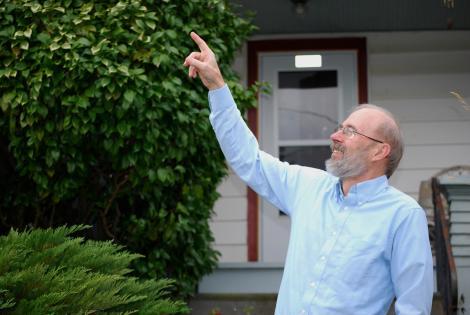David Ortman keeps an eye on the sky
This article has been updated with quotes from Perry Cooper, representing the Port of Seattle. We incorrectly said they could not be reached for comment; we apologize for the error.
Airplane noise grinding your gears? You’re not the only one.
A North Ballard resident has filed claims against the Port of Seattle and Federal Aviation Administration (FAA) seeking compensation for reduced property value as a result of increased airplane noise in northwest Seattle.
David E. Ortman, who claims to have documented hundreds of noisy low flying commercial airplanes — including ones under 3,000 feet — is the man behind the litigation. He was the subject of a Ballard News-tribune article last year, in which he analogized the constant nuisance of the planes to “mosquitoes in a tent.”
“We’re 16 miles from Sea-Tac,” said Ortman in a press release. “With the opening of the Port’s ‘Third Runway,’ FAA directs commercial aircraft northbound up Puget Sound. Then they are turned over northwest Seattle in a low landing pattern back south into Sea-Tac, even when there are no other obstructing airplanes. In addition, FAA directs commercial airplanes arriving from the northwest over northwest Seattle in a low landing pattern into Sea-Tac. These noisy low level landings occur between 4:30 AM to 1:30 AM and have become a noise nuisance.”
In an interview, Perry Cooper from the Port of Seattle said that the third runway Ortman was referring to was the one built in 2008, which is about 1,700 feet to the West of the center runway.
“It’s connected,” Cooper said, referring to residents’ noise complaints. “You’ve got a runway now a bit to the west so you got folks who didn’t have airplanes directly over their head who are experiencing that now.”
But, he said, the flight path of all the planes remains largely the same.
FAA was unable to be reached for comment for this story, citing that they do not comment on litigation.
Ortman said in the press release that the correct pattern should have airplanes approaching Sea-Tac fly over Elliott Bay, rather than disturb residents in northwest Seattle.
In October 2011, Ortman filed an appeal with the King County Board of Equalization, requesting a reduction in property value due to airport noise. Ortman included a year of over-flight documentation and a statement from a new home purchaser in the north Ballard area saying he would not have purchased in the area had he been aware of the noise from low level over-flights.
On Aug. 27, 2012 the Board reduced Ortman’s improvements value and issued an order adjusting the property value downward stating:
“After reviewing the arguments and evidence provided by the parties and considering the noise issue raised by the petitioner, the Board concludes that the comparable sales adjusted for market timing and property differences support the listed value determination for the January 1, 2011, valuation date in question.”
Ortman’s litigation follows a series of community meetings that the FAA held for its Greener Skies program. At the meetings, several residents expressed frustration with the plan, asking why it apparently increased noise instead of decreased it. Officials maintained that there was a very diminutive difference in noise and that the new operation was more efficient and that the planes themselves would create less noise. We covered the meeting held at the Ballard Branch Library back in September.
Ortman was one of the critical community members at the Beacon Hill meeting in November.
